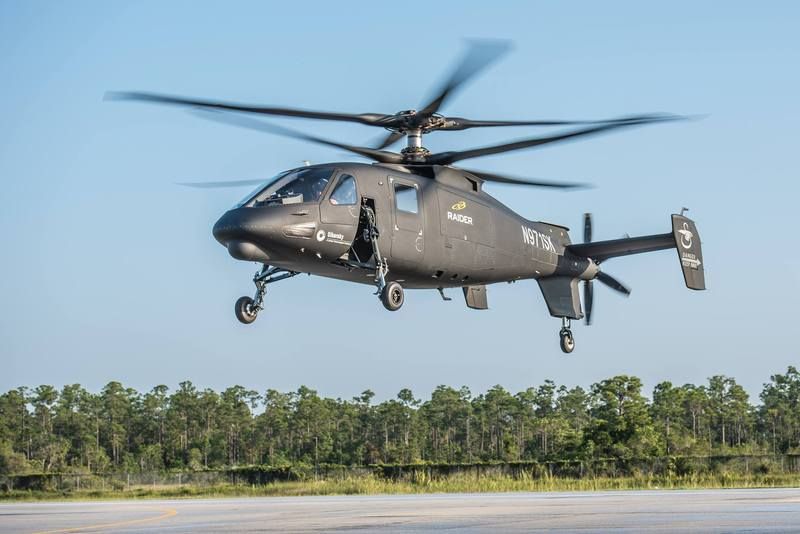S97 Raider
It was just a swag I came up with on a proverbial napkin some time ago, based on disc loading and FM, limited by rotor radius due to minumum hub spacing for high speed forward flight.
I have no doubt you could increase the GW and manufacture larger heavier rotors, however the requisite disc spacing increase sees exponentially diminishing returns in Vmax due to drag.
Also, consider the XH-59A/S-69 tipped the scales at 9,000 lbs and one of the primary goals of its unfunded successor XH-59B was a "significant weight reduction", which ended up eventually yielding a 5,300 lb X2 TD.
I have no doubt you could increase the GW and manufacture larger heavier rotors, however the requisite disc spacing increase sees exponentially diminishing returns in Vmax due to drag.
Also, consider the XH-59A/S-69 tipped the scales at 9,000 lbs and one of the primary goals of its unfunded successor XH-59B was a "significant weight reduction", which ended up eventually yielding a 5,300 lb X2 TD.
I have to question the level or risk when proposing the S-97 Raider as a true competitor for the US Army’s AAS program. Having flown the XH-59A and viewed many of the X-2 videos it is apparent that at this point both aircraft have demonstrated only limited flight envelopes. Straight line speed was first and foremost in both programs. However, I believe that the XH-59A did perform limited maneuvers at altitudes up to 20,000 ft MSL. I am sure that AAS program maneuverability and agility requirements with be very demanding.
I am sure that AAS program maneuverability and agility requirements with be very demanding.

I like the source that says the scaling is limited. Any company exec is always the go-to source for technical information.
Bryan
Bryan
Join Date: Oct 2007
Location: USA
Posts: 147
Likes: 0
Received 0 Likes
on
0 Posts
Thanks Sans, as with everything helicopter it's a trade off between weight and ___________. I imagine that if they think they can scale this up to something Blackhawk sized they're banking the effectiveness of the yet to fly hub fairing and some kind of advanced composite construction techniques? Composites scare me, they're why I chose to go the thermo route rather than structures in college.
I like the source that says the scaling is limited. Any company exec is always the go-to source for technical information.
Pics of the real thing are out - looks great!
http://defensetech.org/2014/10/02/si...t-attack-helo/
Bryan
http://defensetech.org/2014/10/02/si...t-attack-helo/
Bryan
Join Date: Oct 2007
Location: USA
Posts: 147
Likes: 0
Received 0 Likes
on
0 Posts
Interesting to note based on previous discussion, I plopped those photos into power point to compare it against the X-2. Proportionally they're basically the same, disc spacing being the factor I was curious about.
Join Date: Sep 2007
Location: USA
Posts: 601
Likes: 0
Received 0 Likes
on
0 Posts
The most interesting feature shown in these new pictures is the engine cowl. Nice clean installation of the single T706. Hard to tell, but it looks like they route the exhaust aft and disharge it just ahead of the pusher prop. Seems like it would be a good compromise between weight, thrust and IR suppression.
Nice detailing around the hubs and mast too.

Nice detailing around the hubs and mast too.
S-97 RAIDER now in ground test
Sikorsky is making progress! Aircraft is chained to the ramp and they've released a video of the first engine starts.
https://www.youtube.com/watch?v=CdBB...g&spfreload=10
https://www.youtube.com/watch?v=CdBB...g&spfreload=10
Congrats to Sikorsky and Team Raider,
Cheers
(Photo courtesy of Sikorsky)

Cheers
(Photo courtesy of Sikorsky)

It appears to have the side-stick for the copilot on the left side? That would be a rather odd design "feature". Especially highly experienced pilots better be really careful to trick their muscle memory into using the left hand for cyclic control. Could be difficult (read hazardous) in hairy situations.
What's the collective, cyclic up and down?
What's the collective, cyclic up and down?
Join Date: Oct 2002
Location: 1 Dunghill Mansions, Putney
Posts: 1,797
Likes: 0
Received 1 Like
on
1 Post
See time index 1:17 for an explanation of the side-arm controller (collective), cyclic stick (yaw, pitch & roll) & pedals (brakes & comms), c/o Advanced Programs PM Jim Kagdis.
Kudos to Sikorsky on achieving their FF.
I/C
Kudos to Sikorsky on achieving their FF.
I/C





